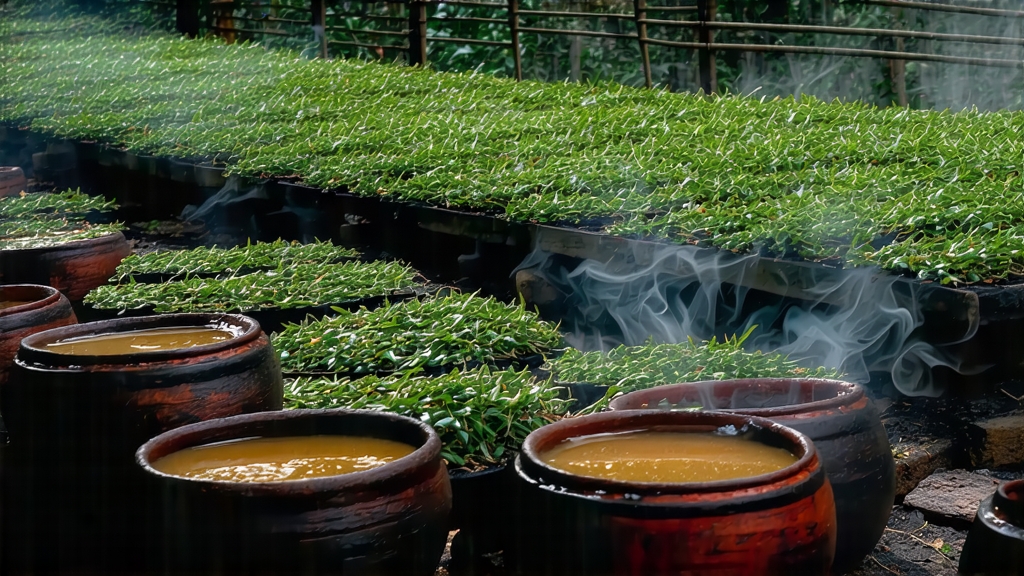
Ask most tea lovers to name a Chinese black tea and they will answer Keemun or Dian Hong; ask a historian which black tea came first and the reply is always Lapsang Souchong. Born in the precipitous Wuyi Mountains of northern Fujian around the late Ming dynasty, this rugged, resin-scented leaf is the progenitor of every red tea (hong cha) that followed. Its story is one of happy accident, military urgency, and the relentless march of global commerce; its flavour is campfire, longan, and the cool granite of a subtropical gorge.
Legend places the birth year at 1646, when Qing armies swept through Fujian and sleeping tea workers, fleeing the advance, abandoned freshly picked leaves. Upon returning they found the crop oxidised far beyond the green tea they had meant to craft. In an attempt to rescue the batch they dried it rapidly over the nearest available fuel—masson pine, abundant on the slopes. The resulting liquor was unexpectedly mellow, its fragrance laced with smoke and dried fruit. Monks from the nearby Xingcun market bought the lot, Dutch traders followed, and by 1607 the first crates labelled “bohea” (the Min-bei pronunciation of “Wuyi”) reached Amsterdam, igniting Europe’s two-century obsession with black tea.
Today the original plant material is still the small-leaf Wuyi cultivar xiao ye zhong, grown between 600 and 1 200 m on weathered tuff soils. Two distinct styles survive. The traditional “smoked” grade, called tarry lapsang, is withered over open pine fires, pan-fired, rolled, then smoked again in bamboo baskets suspended above slow-burning pine embers for eight to ten hours. The “unsmoked” or “craft” grade, increasingly favoured by Chinese connoisseurs, omits the final smoking; instead the leaf is withered on slatted bamboo trays inside charcoal-heated lofts, yielding a sweeter, more Burgundian cup that foregrounds honey, lychee and mineral notes. Both share the same four-step craft: wither, roll, oxidise, dry. Yet within those steps the master must juggle temperature, humidity and timing as deftly as a conductor shaping a symphony.
Withering begins the moment the two-leaf-and-a-bud pluck lands in the courtyard. On clear days the leaf is spread on bamboo mats under a 30 °C sun for twenty minutes to “kill the green edge,” then moved into the qinglang, a second-floor loft whose shutters are cracked just enough to coax moisture away while preserving the leaf’s natural enzymes. When the grassiness subsides and a faint apple-skin aroma rises, the leaf is ready for rolling. A 25-minute mechanical roll bruises cells without pulverising them; the twist must be tight enough to release polyphenol oxidase yet gentle enough to keep the strip whole. Oxidation follows in cedar-lined trays where the leaf rests 2·5–3 h at 24 °C and 85 % humidity. The colour shift from jade to copper is judged not by clock but by nose: when the fragrance tilts from floral to dried-longan the process halts. Finally the leaf is baked in 70 °C bamboo baskets over embers of local masson pine whose resin content is high in α-pinene and limonene, the very terpenes that impart the tea’s signature pine-top note.
To brew Lapsang Souchong gongfu style you need a small yixing teapot or a gaiwan of 120 ml. Use 5 g of leaf—about two heaping teaspoons—rinsed for three seconds in 95 °C water to wake the aromas. The first infusion, 10 s, yields a clear amber liquor with a drifting smoke ring that quickly yields to honey and baked plum. Subsequent steeps lengthen by five-second increments; a good craft-grade leaf will deliver six infusions before the tannins finally surrender. Western drinkers may prefer a porcelain pot and three-minute single infusion, but beware over-smoking: boiling water left too long will drag creosote-like bitterness to the fore.
Tasting follows a three-step ritual taught in Wuyi tea schools. First, “listen” to the dry leaf: rub a few strands between thumb and forefinger; traditional style smells of pinewood and burnt caramel, craft style of dried apricot and meadow-sweet. Second, “watch” the liquor against white porcelain; the rim should